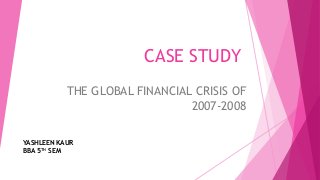
CASE STUDY Financial crisis 2007-8.pptx
- 1. CASE STUDY THE GLOBAL FINANCIAL CRISIS OF 2007-2008 YASHLEEN KAUR BBA 5TH SEM
- 2. SUMMARY The financial crises of 2007 – 2008 was years in making (between year 2000- 2006). The financial crises was primarily caused by deregulation in the financial industry. This began years earlier with cheap credit and no proper lending standards that fuelled a housing bubble. There was a significant growth in lending the money for housing property as rate of interest were very low. Earlier the banks use to lend it to Prime borrowers only over the time as the demands for housing property loans increased they started to lend it to sub prime borrowers.
- 3. SUMMARY (CONTD) They believed that housing prices would continuously rise and hence the borrowers lack of creditworthiness a lack on inadequacy of equity would not be a problem in recovering loan. MBS ( Mortgage backed securities)- Loans were securitised by banks into MBS, a group of mortgage loans. These were then further grouped into CDS (Collateralised debt obligations- is a complex structured finance product that is backed by a pool of loans and other assets and sold to institutional investors. A CDO is a particular type of derivative because, as its name implies, its value is derived from another underlying asset.) A CDO would have different several MBS in it.
- 4. SUMMARY (CONTD) The owner of the CDO securities would enter into derivative transaction called CDS (Credit Default Swap- is a credit derivative contract between two counterparties. The buyer makes periodic payments to the seller, and in return receives a payoff if an underlying financial instrument defaults or experiences a similar credit event). In 2006, housing prices started to fall for the first time in decades, at first they thought the overheated real estate market would return to more sustainable level. They didn’t factor in number of factors, such as too many homeowners with questionable creditworthiness approved for mortgage loan
- 5. SUMMARY (CONTD) When they were unable to pay the loans their property was taken over by the banks. When the value of the property fell many accounts began having a negative equity i.e. the rate of default loans were much higher than expected. Many CDO also began to suffer default payments. Those who have insurance against such defaults by purchasing derivatives begin to invoke the CDS and this created an unexpected liability for banks and insurance companies who had sold the CDS, many of them were unable to meet the liabilities. Many financial institutions collapsed and many suffered losses.
- 6. INTERPREATION The Financial Crisis of 2008 was a historic systemic risk event. Prominent financial institutions collapsed, credit markets seized up, stock markets plunged, and the world entered a severe recession.CDOs were a leading cause of the Great Recession but not the only cause. A decline in the value of CDO's underlying commodities, mainly mortgages, caused financial devastation during the financial crisis. During the Great Recession, the collateralized debt markets collapsed as millions of homeowners defaulted on their mortgage loans. Most of the blame is on the mortgage lenders. That's because they were responsible for creating these problems. After all, the lenders were the ones who advanced loans to people with poor credit and a high risk of default.
- 7. INTERPREATION (CONTD) A lot of criticism has been directed at the rating agencies and underwriters of the CDOs and other mortgage-backed securities that included subprime loans in their mortgage pools. Some argue the rating agencies should have foreseen the high default rates for subprime borrowers, and they should have given these CDOs much lower ratings than the AAA-rating given to the higher quality tranches. If the ratings were more accurate, fewer investors would have bought into these securities, and the losses may not have been as bad. We should also mention the homebuyers who were far from innocent in their role in the subprime mortgage crisis. Many of them played an extremely risky game by buying houses they could barely afford. Investment bankers worsen the situation, The increased use of the secondary mortgage market by lenders added to the number of subprime loans lenders could originate. Instead of holding the originated mortgages on their books, lenders were able to simply sell off the mortgages in the secondary market and collect the originating fees.
- 8. INTERPREATION (CONTD) Just as the homeowners are to blame for their purchases gone wrong, much of the blame must also be placed on those who invested in CDOs. Investors were the ones willing to purchase these CDOs at ridiculously low premiums There may have been a mix factors and participants that precipitated the subprime mess, but it was ultimately human behavior and greed that drove the demand, supply, and investor appetite for these types of loans.
- 9. VOLCKER RULE Volcker Rule- As used in the Volcker Rule, financial instruments consist of the following: securities, including options on securities; derivatives (including swaps and security-based swaps), including options on derivatives and forwards;7 or. commodity futures, or commodity futures options. The Volcker rule generally prohibits banking entities from engaging in proprietary trading or investing in or sponsoring hedge funds or private equity funds It is to ensure that investment activities are not undertaken by banks.